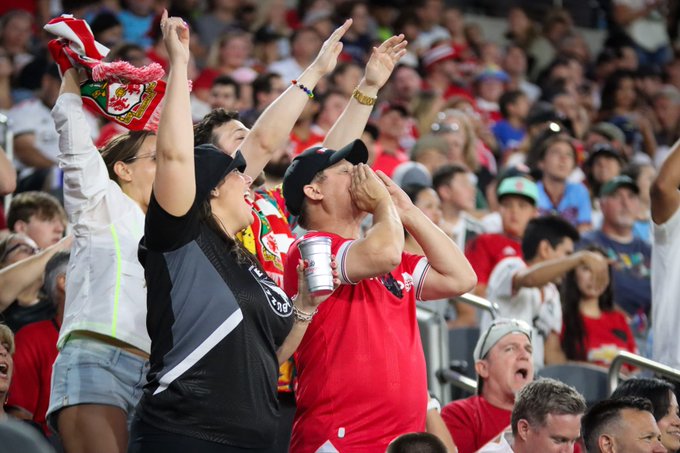In 2008, Wrexham A.F.C. was relegated (moved down a division) to non-League football, which ended an 87-year stay in league play. The club, which was once a dominant force in football, was on the precipice of total financial collapse, and its fans spent the next 12 years wondering whether the club would ever get back on its feet, let alone return to its old form.
In 2023, the football association’s players sweat in jerseys sporting its new sponsor, United Airlines. Its women’s team shattered the Welsh women’s record for highest fan attendance with 9,511 fans (the old record was 5,175). What led to such a dramatic turnaround for one of Wales’ most storied football clubs? Two American celebrities: Ryan Reynolds and Rob McElhenney.
New Owners Change Fate
Wrexham A.F.C. has been in news headlines ever since Reynolds and McElhenney purchased the Welsh football (soccer) club in November 2020. In less than three years, the new ownership has revitalized Wales’ oldest and the world’s third-oldest professional football club.
The transformation has taken place both on and off the field. The women’s first team will compete in the top Welsh division next year, and the men’s team won promotion to the English Football League (EFL) Two after winning the 2023 National League in April, its first league title in 45 years.

Photo Courtesy Wrexham AFC
The full story of Wrexham A.F.C. and the city of Wrexham itself is complicated. If you don’t believe me, there’s an ongoing, multi-season documentary on the club itself, and even that only tells part of the story. To start, one needs to understand (or have some grasp on) the English football pyramid system (bum bum bummmm).
English Football Leagues
Countries worldwide have their own football leagues, each with governing bodies, leagues, and rules. In most systems, teams in the same league play each team twice, once at home and once away. A win is worth three points, a draw (or tie) is worth one point, and a loss is worth zero points.
At the end of the season, a team’s order is determined by their overall point tally, with the highest-scoring team winning the league.
Other than the top division in England, the Premier League (EPL), the top-placed teams in a league win a chance to move up to play in the higher-rated league above theirs the following season, which is called promotion.
The lowest teams in the league table move down to the lower-rated division, which is called being relegated. Most clubs have little money to pay top-tier players and maintain club operations, so winning promotions can truly change a clubs’ fortunes, as the higher-tier leagues bring more money from attendance, TV deals, and better coverage.

The league directly under the Premier League (reminder: it has 20 clubs) is the EFL, which consists of three divisions, each with 24 clubs. The EFL Championship is the best division in the league, making it England’s second-best division overall.
The top two teams in the Championship win automatic promotion to the Premier League at the end of the season, and the third through sixth-place teams play a knock-out tournament, with the winner gaining promotion. Those three teams move up, and the three worst teams in the Premier League move down. And no, there isn’t a winner-stays-in tournament for relegation.
The final knock-out match between the Championship teams is often called the richest game in football because the winning team’s revenue will increase by an estimated £135 million in the following three years!
The division under the Championship is called the EFL League One, and it promotes three teams at the end of each season while relegating four teams. The last division is (unsurprisingly) called the EFL League Two, and it promotes four teams at the end of each season while relegating two.
The Premier League and the three divisions within the EFL are considered to be the four professional leagues in the English football system. The rest of the divisions below the Premier League and EFL are considered semi-professional and referred to as “non-league” teams. These teams are still full of highly skilled and aspiring players and aren’t the same as amateur associations like Sunday League (though Sunday Leaguers across the country will swear they are!).
See? Easy and straightforward to understand. Next up: the history of Wrexham A.F.C, which can loosely be described as the birth, rise, fall, and rise of Wrexham.





